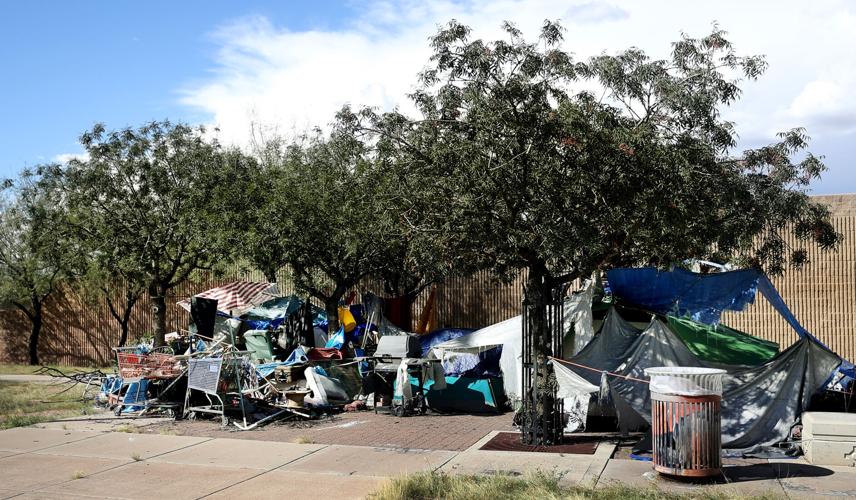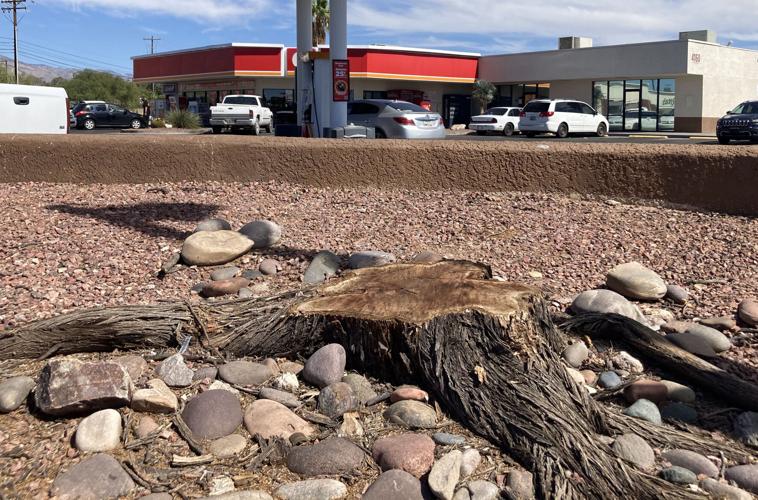You have to search to see the stumps that signal the missing mesquites in front of Circle K at North 1st Avenue and East Limberlost Drive.
The two cut-down trees at the Speedway gas station on the corner of East Speedway and North Alvernon Way were behind the business. You wouldn’t know they’re gone unless you frequented the area.
The Navajo Wash Park trees are different. The approximately 75 stumps leave an unmistakable gap in the landscape near North Mountain Avenue and East Fort Lowell Road. Local residents had planted many of them 15 years ago and nurtured their growth.
All these trees were cut down for the same set of reasons — the presence of unwanted people, maybe unhoused or addicted, hanging out or camping under the trees, causing a variety of problems.
It turns out the tree massacre at Navajo Wash Park was part of a broader pattern of people cutting down trees in spots across Tucson as a simple way to deal with our visible social ills. Wherever it’s done, it leaves another gap in the meagre tree canopy that residents and city officials are trying to build as temperatures rise.
Long before the Hedrick Acres Neighborhood Association used a donation, apparently from a neighborhood business owner, to pay someone to cut down the Navajo Wash Park trees, Meg Johnson was warning of this problem. Johnson, the secretary of the Garden District Neighborhood Association, listed examples of cut-down trees in a June 2022 letter to the mayor and council.
“Residents and businesses are frustrated and angry, unsure about how to handle the impact of the unsheltered on their homes and businesses. Steps must be taken to educate the public, especially management companies and small business owners, about the monetary, aesthetic, and environmental value of trees.”
This pattern of course runs counter to one of Mayor Regina Romero’s top priorities — increasing tree coverage in order to combat the effects of the increasingly hot climate.
It amounts to a sort of collision of the mayor and council’s policies. On the one hand, they want to increase Tucson’s tree canopy by planting a million trees, but on the other hand, their homeless protocol allows for tolerating some camps, as long as they are not causing health and safety problems. That tolerance can lead to tree-cutting.
An implausible rationale
This does not justify cutting down 75 trees on public property in Navajo Wash Park, of course. The secretary of the Hedrick Acres Neighborhood Association, Adrian Wurr, claimed that it was fears of fire and flooding that motivated the decision to pursue cutting the trees down altogether.
I don’t think this explanation gives the whole story.
Wurr, along with neighbor Allison Bradford and nearby business owner Michael Carlson, are the plaintiffs in a lawsuit against the city. Filed Sept. 20, it argues — persuasively, I think — that the city has abandoned its duty to deal with the public nuisance of unhoused people hanging out in Navajo Wash Park and openly using drugs, going to the bathroom or having sex.
Their legal action over people camping and hanging out in the wash unfolded during the same period when Wurr and Carlson were working together to clear the trees, according to a posting by the neighborhood association in its Google Group.
“TDOT did an assessment at the end of August and is scheduled to trim the trees in the center of the wash on 10/23/23. However, there are some caveats. City workers won’t enter the wash if active homeless camps are present and they will not cut trees down, only trim them back, etc. Rather than wait for the next heavy storm or large fire, Mike Carlson of The Carlson Company — Plumbing, Heating and Air Conditioning offered to pay someone to do the job for us, and we gladly accepted.”
So, at the same time Wurr, Carlson and the neighborhood association were taking legal steps to deal with the public nuisances, they were also taking a potentially illegal path — cutting down the trees themselves. Tucson police are investigating whether this amounts to criminal damage or another crime.
Such a case has been mounted before. In 2019, a midtown resident was charged with criminal damage for cutting trees on city property in the Christmas Wash, but the case was settled in 2021 with a payment made to the city and charges dismissed.
Carlson, whose business is less than a block from the wash, did not respond to my requests to speak with him on this issue. The director of an agency next door, Ben Irving of Project Insight, told me that problems have increased in recent months, including 3 or 4 break-ins at a new shed on their property.
“Hand sanitizer, adult diapers — those are the kinds of things in the shed,” he said. “People see a locked door and they think there must be something valuable in there.”
The politics behind the saw
The people cutting down trees at their businesses around town don’t seem to have a political motive. They’re just taking the simplest step to solve an immediate problem on their property.
I don’t believe the same is true of those who engineered the tree cutting at Navajo Wash Park during this city election season. Carlson has been a vocal critic of the mayor and council and even has a sign saying “Vote Romero Out” on the front door of his business.
His wife Monica is also a co-founder of the Tucson Crime Free Coalition, which has voiced strong opposition to Romero and incumbent council members over public-safety issues. They want a more law-and-order approach to addiction and homelessness on Tucson’s streets, as opposed to the partially tolerant approach the city has chosen.
Wurr has written on the neighborhood Google group: “Long-term, please do not vote for any incumbant (sic) city council member except Steve W.” (There is no Steve W. on the council, but this may be a reference to Steve Kozachik, who is not up for election this year.)
You could view the incident at Navajo Wash as a political lashing out. People like Carlson and Wurr are angry at the city for what they view as inaction. But the city has been following its homeless protocol, monitoring the camps and intervening when they see a health and safety violation.
It’s a policy disagreement that ended up with members of a frustrated political minority having dozens of trees cut down.
Crossing a line?
This sort of vigilante action will inspire some support, but I suspect for most Tucsonans, it crossed a line. Yes, we’re all frustrated at the social problems playing out in our streets and neighborhoods, but cutting down trees on public property is going too far.
We are, after all, the city who voted for a mayor who listed climate action as her top priority and planting a million trees as a signature goal. As voters in a hot desert city, we value trees, especially mature ones like some of those cut down in the wash.
So far, the city counts around 100,000 trees planted in Romero’s first term, according to Nicole Gillett, the city’s urban forestry program manager. It’s an inexact figure in part because the city is trying to count the number of trees planted outside of their own efforts by private parties.
The problem is, mature trees that have been growing for more than a decade do much more for us than newly planted ones. They reduce the temperature, capture rainwater, sequester carbon and even benefit us psychologically.
“The benefits a mature tree gives you are almost incalculable,” Gillett said. “It’s very difficult to replace a 15-year-old tree in our landscape.”
She recommended that property owners having trouble with people gathering under their trees judiciously prune them so there are better sight lines underneath. She also noted that city codes may require businesses to keep some of the trees they’ve been cutting down.
Still, city officials ought to see what’s happening. It’s not just their political opponents lashing out by cutting down trees. It’s also people who see reducing our tree canopy as the simplest way to solve a problem that the city either won’t or can’t.
Get your morning recap of today's local news and read the full stories here: tucne.ws/morning.






